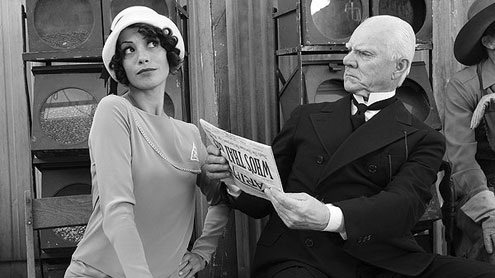 Watching a silent movie in 2012 is an odd experience. Watching a silent movie made in 2011 in a movie theater is even odder.
Watching a silent movie in 2012 is an odd experience. Watching a silent movie made in 2011 in a movie theater is even odder.
But that’s what I found myself doing last Friday, when “The Artist” finally made its way down South to the local theater.
“The Artist” is a great movie, but it took about the last 20 of its 100-minute runtime to truly convince me. We have a Lifestyles section for movie reviews (see page six), though, so I’ll get on to my point.
Watching a silent movie is and will always be an exercise in reading face and body expressions. There’s a telling scene in the second act of the movie, when Bérénice Bejo’s character, Peppy Miller, talks to an interviewer about being the big star in those newfangled talkies.
She mentions (via title cards, of course) how silent films were all about “actors mugging at the screen,” mimicking the exaggerated faces as she talks.
After the film was over and my friends and I were standing outside the theater, there was a brief moment when I paid particularly close attention to their facial expressions. It was fleeting, and obviously a tendency leftover from an hour and a half of no one speaking, but it was still remarkable to look at a friend with the same curiosity and intensity that is required of a silent-film audience.
Of course, the ideal is to pair meaningful dialogue with telling facial expression, as we see in the climax of “The Artist” as well as film’s own history. Still, it only seems appropriate to use “The Artist” as a backdrop to examine where human communication is today.
The reason it seems appropriate is because of the pervasive use of technology as the standard medium through which we communicate. Not that it’s a negative aspect of our culture – quite the opposite, in fact. This isn’t a column lamenting “Generation Text” and our lack of interpersonal relationships, like I don’t also have TweetDeck open on the other side of the screen at this very moment.
The question is whether this self-imposed 140-character limit is beneficial to human communication as a whole. Those in favor would say it forces individuals to get to the point faster; to not waste time with flowery language that muddles the actual message.
The flipside of that point is that by eliminating the flowery language, we are also eliminating the beauty of language as a whole, though I might be inclined to argue that there is certainly some charm in the creativity people employ to get down to the character cap.
What I find the most fascinating is that in its own way, the character limit actually serves to point out how reliant we are on nonverbal expression.
We’ve all had an experience when sarcasm didn’t translate via text message. And as much as I’ll always associate this with America Online instant messages, we still rely on emoticons to get across the finer points – the scalpel counterpart to the textual sledgehammer that is a tweet.
As much as high school English teachers might disagree, language is an ever-evolving concept. With it, too, is human expression. Hollywood moved from silent films to talkies 80 years ago, but 80 years on, it seems all we want is a few lines of text. Maybe in another few decades or so, we’ll just be walking around winking at one another.
John Davis is the chief copy editor of The Crimson White. His column runs on Mondays.









